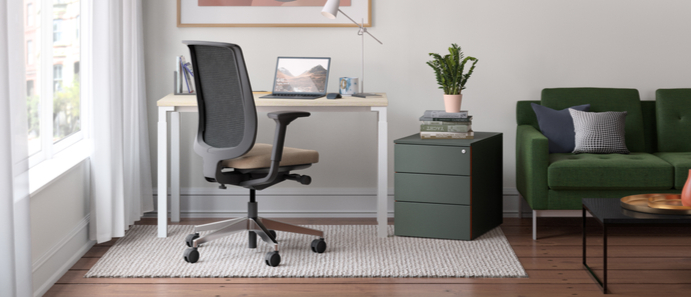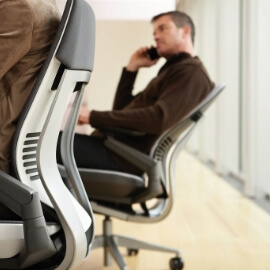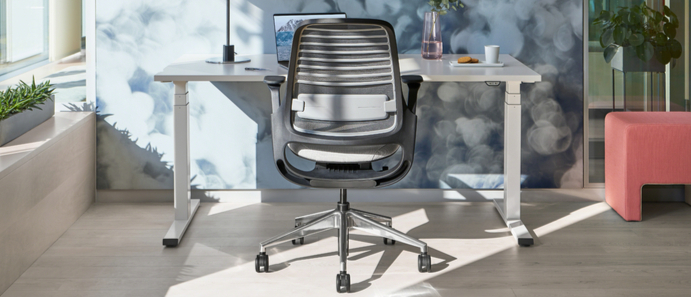
Nearly a year into a locked down world and despite all the difficulties there have been some notable upsides for homeworkers. But the research is still showing one significant problem. Many of us are still missing the home office furniture basics that can make us more comfortable and productive.
The WFH success story
Working in lockdown hasn't been all bad. We've reconnected with our families, ditched the terrible commute and discovered what our cats do all day (nothing).
12 months into the crisis, companies have also reported positive commercial outcomes from their year of working differently.
They've seen increases in productivity and lowered many of their overheads. In fact, the mass WFH experiment has been so successful, firms like Fujitsu are planning to reduce their office space and introduce flexible working patterns for their 80,000 employees worldwide.
Research shows a persistent problem
But there have obviously been problems for those adjusting to WFH, too. Despite those inspirational articles about workers improvising space-saving, yet ergonomic workstations under the stairs and in cupboards - the reality for many has been discomfort and disappointment in their WHF set up.
In the latest Steelcase global study:
Only 30% of people said their home workspace was comfortable
Only 26% said they had ergonomic chair at home, though most wanted one
Meanwhile, research into homeworkers habits conducted by Maru/Blue in November 2020 found that:
14% of people are working from their sofas
6% are working from their beds
50% claim they have had to spend their own money improving their home working space
and most significantly:
63% of home workers have experienced productivity issues due to an inadequate homeworking set-up
It seems many companies have not yet addressed some of the long term implications of more people working from home. Many still need to figure out how they can properly support physical well being and understand what compliance responsibilities they have when these short term WFH fixes become formal, long term arrangements.
The Home Office Furniture we all need -and how to use it
As we gear up to a future of more flexible working - companies need to step up their level of support for those working from home.
But the good news is, no matter what size space they have at your disposal, it’s more than possible to find and fit out a workstation that can help your people focus and be productive while at home.
Here’s our list of must have equipment that could make everyone’s WFH experience a whole lot easier
1. An ergonomic chair
It’s an article faith that an ergonomic chair is good for posture and improves our levels of focus - but what does that really mean:
- The backrest of the chair should fit the natural S shape of the spine and prevent slumping
- Seat depth should leave 5 - 10 cms between the edge of the seat and the back of the knees.

- Height should be adjustable to allow users to place their feet flat on the floor while seated
- The seat should move as the body does. Tilting back and forward as you adjust your posture..
- The seat should keep the pelvis in a neutral position, maintaining 80-degree angles at the hips, knees and ankles.
- Contoured foam and a flexible edge should provide pressure-free comfort for sitting bones, glutes and thighs.
- The arms of a chair should stay parallel to the floor while a user reclines – keeping their arms straight on their desk and their eyes level with the screen.
- Intuitive back, seat and arm adjustments make a chair feel like it is made for a users body.

2. A (height adjustable) desk
Height adjustable desks are ideal, but there are other ways we can optimise our work surfaces
- Choose a desk or work surface that can easily accommodate laptops, keyboards and phones, as well as personal items for customisation. If space is at a premium consider options with shelves, cubby holes or drawers for storage and display
- The work surface should be at elbow height when a user is in a seated posture
- Height-adjustable desks give the option to change postures: sit, stand and move, while still focusing on work.
- The addition of an Active Lift Riser is one option to transform a stationary desk into a height adjustable work surface with no disruption or heavy lifting required.
- Clear enough space for knees beneath desks so chairs can be moved closer to work when necessary
3. The stuff that makes it all more manageable
Fit monitor arms to workstations. This will allows users to move a screen to suit any working posture, reducing eye and muscle strain, while increasing comfort and productivity.
A keyboard platform will keep a keyboard and mouse on the same horizontal surface and at the right height, maximising ergonomic potential
Foot rests can help people sit (and stand) more comfortably while working - curved and adjustable they can enhance posture and keep workers ‘on task’ for longer.
A mobile laptop support allows workers to position their laptop at a height that’s comfortable for them - light, collapsible and easy to re-assemble - they can be moved from room to room throughout the day.
And if you’ve got the space, dual monitors have been shown to significantly enhance worker productivity
Home office support - a new challenge to recruit and retain?
There's still a long haul ahead of us before shared workspaces can reopen - and many companies are planning for a much greater role for home working, anyway.
The research is showing worker enthusiasm for these more flexible working scenarios , but disappointment in the level of help they're getting to make their home working spaces more comfortable and productive.
In the drive to recruit and retain skilled staff in a remote working world, support around home office set up may yet become the new corporate battleground.











